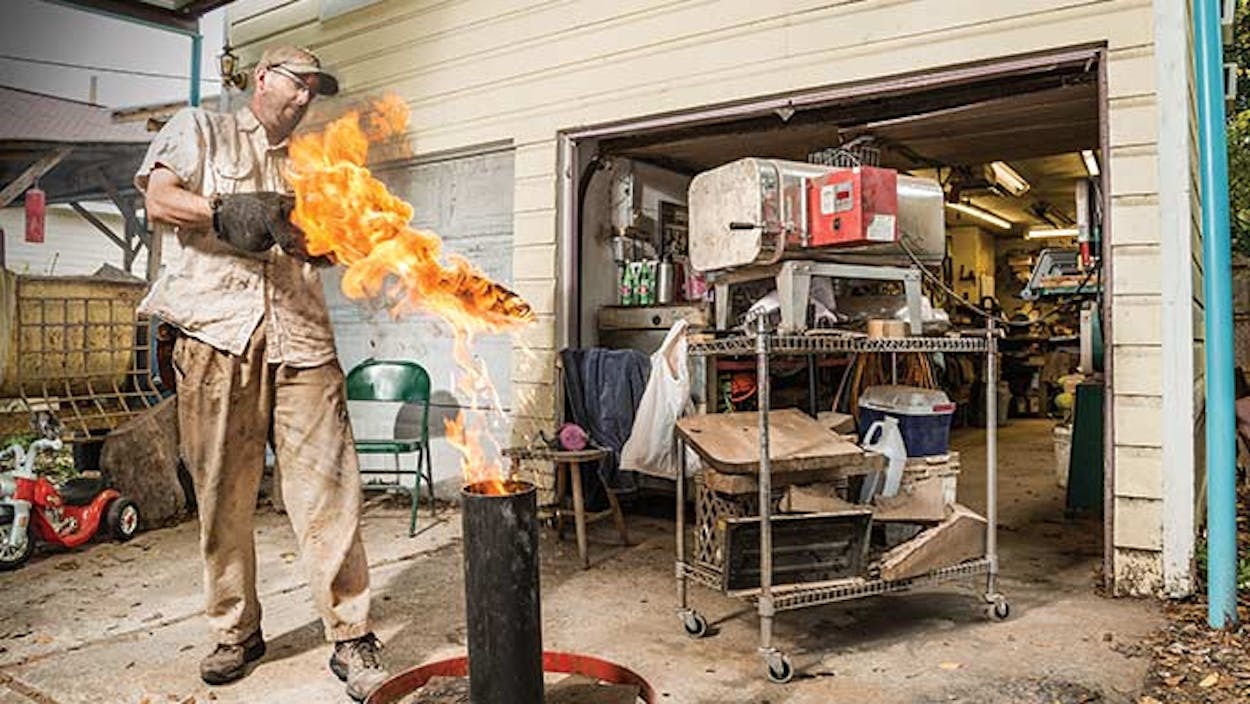Five years ago, Russell Montgomery was managing a Starbucks and dreaming of starting his own business. His wife, Elizabeyta, suggested knife making, because he had been fascinated by sharp edges as a kid—the blades of the skates he used as a competitive ice skater, the viking axes he spent hours throwing at trees. He took her advice and began learning about the craft, even going to Oregon to train with legendary knife maker Murray Carter, who leads the only traditional Japanese bladesmithing school in the United States. In 2012, just two years after making his first knife, Montgomery was commissioned to make steak knives for Houston hot spot Oxheart. Other restaurants soon followed, like Dallas’s Mansion on Turtle Creek and Las Vegas’s Bazaar Meat.
Today he has made over 550 blades,from oyster and chef’s knives to straight razors and machetes, and he says that this work is the only thing that has ever brought him a true sense of calm. “The day I came up with the name for my business, I went into my shop and worked for eight hours without stopping. I felt so at peace, very zen. ‘Serenity’ just came to me, and I thought it was perfect.”
Q&A with Russell Montgomery
Tell me about the first knives you made.
I made my first five knives on my own, before my training with Murray Carter, using a set of guidelines given to me by Jim Lemke, of Texas Knifemaker’s Supply. When I finished the first knife, he gave me some pointers and advice, and I started another one.
Did you ever cut yourself in those early days?
I left the first knife I ever made in a vise the wrong way and cut my right hand to the bone with a four-inch gash. I just used superglue to close it back, and it healed. Some surgeons have looked at it since and said they couldn’t have done a better job fixing it.
What skills have you learned over the past few years?
I’ve learned forging, woodworking, welding, grinding and cutting metal, sharpening, drilling steel and wood, joinery, sandblasting, and chemical etching. I spend most of my time using my grinder, which is the knife maker’s workhorse.
Which part of the process do you like best?
The planning stage. I love sitting down with my sketchbook and doing the initial design. That’s where you have the biggest change, going from a bar of steel to a unique knife.
What kind of steel do you use?
I use 52100, a complex, high-carbon steel with some chromium in it. I like it because it patinas beautifully but has good rust and stain resistance at the same time. It takes and holds an excellent edge, and it gets nice and shiny.
How do your chef’s knives differ from commercial knives?
My knives are designed to cut; commercial ones are designed not to break. And since we do every step by hand, that means each knife gets individual attention and there are lots of chances to catch errors.
You have made some striking knife handles. What exotic materials have you used?
I’ve used oosik, the 50,000-year-old fossilized penis bone from a walrus, and ivory from the tusks of the woolly mammoth, which is between 10,000 and 20,000 years old. I have absolute respect for how rare they are and am very careful and meditative while working with them.
What’s next for you?
Making full-size swords! It’ll test all my combined skills in one large piece.
Any tips on knife care for the home cook?
Hand-wash your knives, properly store them with nothing hitting the edges, and only use a nice end-grain wooden cutting board.
For more information, go to serenityknives.com.







